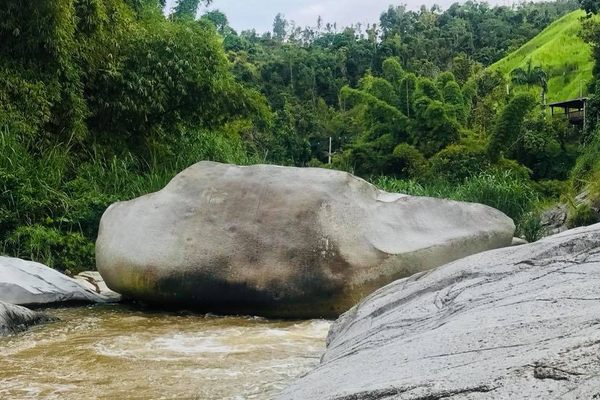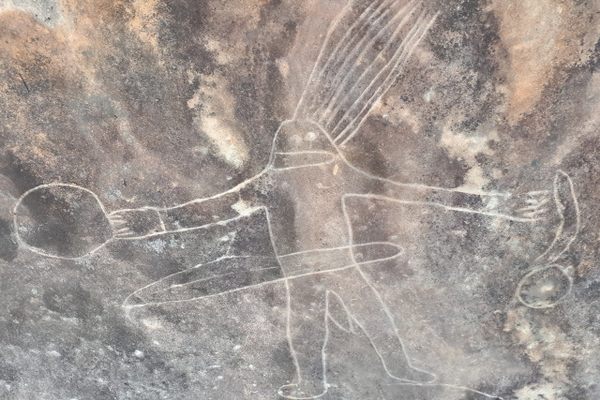About
The natural world has a story to tell. Trees arch majestically into the sky, each branch and leaf a tale of years turning to decades turning to centuries. Water carves rocks, drop by drop, until they become canyons. And sometimes, the stories the natural world tells are helped along by human hands. We build and create and shape, leaving our mark on all the places we’ve touched. What’s left behind is the story of a people, of a world and time before us, of who they were and what mattered to them. You can find some of those stories in the rock art of Kakadu National Park in Australia’s Northern Territory.
The park, which is a UNESCO World Heritage Site, is home to thousands of spectacular examples of Aboriginal art that date back at least 20,000 years. Nestled among the park's 20,000 square kilometers (8,000 square miles), the rock drawings depict the daily lives of the Bininj/Mungguy who have called the area home for over 60,000 years. The paintings, or kunbim, reflect hunting practices, historical, educational, and social stories, and some were just for fun. Some of the images were sorcery paintings, and could only be painted by those who knew exactly the power the images held. These images, of wildlife, of spirits, of early contact with Europeans, represent the longest historical records of any civilization on earth.
What is perhaps the most stunning collection of art is Ubirr, which not only depicts the day-to-day life of Aboriginal people, but also recounts some of the earliest meetings between Aboriginal and non-Aboriginal people. Many of the drawings are also excellent examples of a style called X-ray art, in which figures—both human and animal—are depicted with internal organs and bone structures. Rock art in Ubirr also tracks the past with a painting of the thylacine (also known as the Tasmanian tiger), a species that has been extinct on the Australian mainland for more than 2,000 years.
As vivid as these images are, there are still tales that are held closely in the community. The original meanings behind some drawings have been lost or are reserved for select members of the community. There are also paintings where the history remains private, only known to a certain few.
Though the artwork may be ancient, the lineage of its creators stretches into the present, and many of the drawings represent practices that are still in use today. The artwork is a glimpse at a past that is kept alive in the present.
As First Nations conservationist and storyteller Lille Madden explained in a 2022 Conde Nast Traveler article, “When you go to a place, it’s beautiful to look at this tree or forest, but when you hear stories that have been passed down through generations about the significance of that place, that deeper connection and understanding grounds you so much more.”
Related Tags
Know Before You Go
Park passes are required. Price varies based on season, children 4 and under are free.
The main rock art galleries are at Ubirr and Burrungkuy (Nourlangie). Kakadu is a beautiful, wild place, with lots to explore. Due to the long stretches of land, it's good to make sure you are well-equipped for a safe trip. It's good practice to always check the road conditions and weather before traveling. Camping in the park is permitted at the two campgrounds—one managed campground suitable for families and RVs, the other backcountry camping with fewer amenities— near the rock art. Both operate on a first-come-first served basis, but there are required fees. Some parts of the park will not have cell phone reception, so plan accordingly.
Most travelers plan their travel in the dry season (April to October), but adventurous travelers who choose to visit in the wet season will be rewarded with overflowing waterfalls, impressive lighting shows, and thriving wildlife. Guided tours of the rock art are available during the dry season, and the rock art at Burrungkuy (Nourlangie) is open for self-guided tours during the rainy season.
Published
April 6, 2023
Sources
- https://www.metmuseum.org/toah/hd/xray/hd_xray.htm
- https://www.cntraveler.com/story/australia-indigenous-landback-future-of-travel
- https://northernterritory.com/gb/en/kakadu-and-surrounds/destinations/kakadu-national-park
- https://www.smithsonianmag.com/sponsored/8-ways-to-encounter-authentic-aboriginal-experiences-in-australias-northern-territory-180981633/
- https://parksaustralia.gov.au/kakadu/do/rock-art/
- https://whc.unesco.org/en/list/147/


























